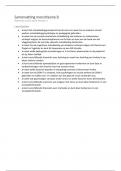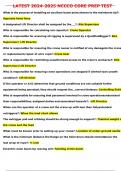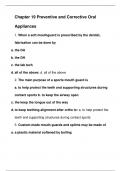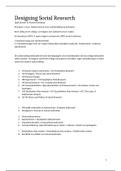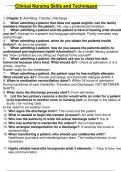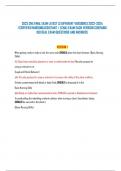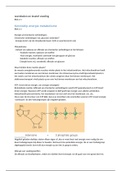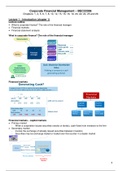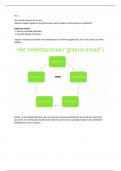Strategic Management
CH1
- Strategic competitiveness achieved when a firm successfully formulates and
implements a value-creating strategy
- Strategy integrated and coordinated set of commitments and actions design to exploit
core competencies and gain competitive advantage
Firms chose from competing alternatives what to do VS what not to do
- Competitive advantage strategy which competitors are unable to duplicate or find too
costly to imitate
Confirmed when imitation attempts fail the advantage is not permanent
- Above-average returns returns in excess of what an investor expects to earn from other
investments with a similar amount of risk
Risk investor’s uncertainty about the economic gains or losses that will results from
a particular investment must be effectively managed
Measured in accounting figures, stock market returns, speed of growth
Achieved through exploiting competitive advantages
- Average returns returns equal to those an investor expects to earn from other
investments with a similar amount of risk
- Strategic management process full set of commitments, decisions and actions required
for a firm to achieve strategic competitiveness and earn above-average returns
Analyzing external VS internal environment resources, capabilities, core
competencies (strategic input sources)
Competitive landscape
- Evolving nature of competition volatile markets + boundaryless industries +
globalization + technological changes
- Hypercompetition assumptions of market stability replaced by notions of inherent
instability and change
Based on dynamics of strategic maneuvering among global and innovative competitors
Competitions based on price-quality positioning, new know-how and first-mover
markets
Caused by global economy + rapid technological change
Global economy economy in which goods, services, people, skills, ideas move
freely across geographic borders
- Globalization increasing economic interdependence among countries and their
organizations as reflected in the flow of goods and services, financial capital and
knowledge across county borders
Large number of firms competing against each other in an increasing number of global
economies
Higher performance standards in competitive dimensions quality, cost, productivity,
product introduction and operational efficiency must be met
Overdiversification in global markets can have negative effects
- Technological diffusion VS disruptive technologies
Technology diffusion rate at which new technologies become available and are used
Perpetual innovation how rapidly and consistently new information-intensive
technologies replace older ones
Disruptive technologies technologies that destroy value if existing technology and
create new markets
Information age + increasing knowledge intensity growing value of intangible
resources
, - Strategic flexibility set of capabilities used to respond to various demands and
opportunities existing in a dynamic and uncertain competitive environment
Continuous learning
I/O model of above average-returns
External environment attractive industry strategy formulation assets and skills
strategy implementation superior returns
- Explains the external environment’s dominant influence on a firm’s strategic actions
Industry and industry segment have a stronger influence on performance than internal
managerial choices
Firm performance determined by range of industry properties economies of scale,
barriers to marker entry, diversification, product differentiation and degree of
concentration of firms in an industry
Returns are determined primarily by external characteristics rather than by the
firm’s unique resources and capabilities
- Underlying assumptions
External environment imposes pressures and constraints that determine strategies that
can result in above-average returns
Most firms competing within an industry or segment are assumed to control similar
strategically relevant resources and to pursue similar strategies based on such
resources
Recourses used to implement strategies are assumed to be highly mobile across firms
resource differences are short lived
Organizational decision makers are assumed to be highly rational and committed to
acting in the firm’s best interest assume profit-maximizing behaviors
Five forces model to identify attractiveness of an industry and most advantageous
positioning given the structural characteristics
Resources based model of above-average returns
Resources capabilities competitive advantage attractive industry strategy
formulation and implementation superior return
- Each organization is a collection of unique resources and capabilities the uniqueness of
such is the basis for the firm’s strategy and ability to achieved above-average returns
Resources inputs into a firm’s production process capital equipment, individual
skills, patents, finances physical, human & organizational capital tangible VS
intangible
Capabilities capacity for a set of resources to perform a task or an activity in an
integrative manner
Core competencies capabilities that serve as a source of competitive advantage for
a firm over its rivals
- Differences in performances across time occur because of firm’s unique resources and
capabilities rather than the industries structural characteristics
Firm’s acquire and develop resources and capabilities based on how they combine and
use resources not highly mobile across firms
Differences in resources and capabilities are the basis for competitive advantage
become stronger and more difficult to imitate through continuous use
The chosen strategy should allow a firm to use competitive advantages in an
attractive industry
- Resources are valuable/rare/costly/nonsubstitutable
If all are met then resources and capabilities become core competencies
- Vision picture of what the firms want to be and what it wants to ultimately achieve
, - Mission specifies the business in which the firm intends to compete and the customers
it intends to serve
- Stakeholders individuals and groups who can affect the firm’s vision and mission, are
affected by the strategic outcomes the firm achieves through its operations and who have
enforceable claims on the firms performance
Capital market stakeholders shareholders/banks
Product market stakeholders primary customers, suppliers, host communities
Organizational stakeholders managers, employees
- Strategic leaders people located in different parts of the firm using the strategic
management process to help the firm reach its vision and mission
- Organizational culture complex set of ideologies, symbols and core values that are
shared throughout the firm and that influence how the firm conducts business
- Profit pool total profits earned in an industry at all points along the value chain
CH2
External environment
- Threats and opportunities affect strategic action
General environment composed of dimension in the broader society that influence
an industry and the firms within it segments
Analysis of environmental trends
Industry environment set of factors that directly influence a firm and its competitive
actions and responses: the threat of new entrants’, power of suppliers, power of
buyers, threat of product substitutes and intensity of rivalry interaction determines
industries profit potential
Analysis of factors and conditions influencing an industry’s profitability potential
Analysis of competitors predicting competitors’ actions, responses and intentions
External environmental analysis
Opportunity condition in the general environment that if exploited helps a
company achieve strategic competitiveness
Threat condition in the general environment that may hinder a company’s efforts
to achieve strategic competitiveness
- Components
Scanning identifying early signals of environmental changes and trend
Monitoring detecting meaning through ongoing observations of environmental
changes and trends
Forecasting developing projections of anticipated outcomes based on monitored
changes and trends
Assessing determining the timing and importance of environmental changes and
trends for firms’ strategies and their management
- General environment segments
Demographic population size, age structure, geographic distribution, ethic mix,
income distribution
Economic nature and direction of the economy in which a firm competes or may
compete
Political/legal arena in which firms compete for attention, resources and voices and a
say in the regulations that define the interactions among governmental agencies and
firms
Socio-cultural attitudes and cultural values
Technological segment institutions and activities involved with creating knowledge
and translating that knowledge into outputs
CH1
- Strategic competitiveness achieved when a firm successfully formulates and
implements a value-creating strategy
- Strategy integrated and coordinated set of commitments and actions design to exploit
core competencies and gain competitive advantage
Firms chose from competing alternatives what to do VS what not to do
- Competitive advantage strategy which competitors are unable to duplicate or find too
costly to imitate
Confirmed when imitation attempts fail the advantage is not permanent
- Above-average returns returns in excess of what an investor expects to earn from other
investments with a similar amount of risk
Risk investor’s uncertainty about the economic gains or losses that will results from
a particular investment must be effectively managed
Measured in accounting figures, stock market returns, speed of growth
Achieved through exploiting competitive advantages
- Average returns returns equal to those an investor expects to earn from other
investments with a similar amount of risk
- Strategic management process full set of commitments, decisions and actions required
for a firm to achieve strategic competitiveness and earn above-average returns
Analyzing external VS internal environment resources, capabilities, core
competencies (strategic input sources)
Competitive landscape
- Evolving nature of competition volatile markets + boundaryless industries +
globalization + technological changes
- Hypercompetition assumptions of market stability replaced by notions of inherent
instability and change
Based on dynamics of strategic maneuvering among global and innovative competitors
Competitions based on price-quality positioning, new know-how and first-mover
markets
Caused by global economy + rapid technological change
Global economy economy in which goods, services, people, skills, ideas move
freely across geographic borders
- Globalization increasing economic interdependence among countries and their
organizations as reflected in the flow of goods and services, financial capital and
knowledge across county borders
Large number of firms competing against each other in an increasing number of global
economies
Higher performance standards in competitive dimensions quality, cost, productivity,
product introduction and operational efficiency must be met
Overdiversification in global markets can have negative effects
- Technological diffusion VS disruptive technologies
Technology diffusion rate at which new technologies become available and are used
Perpetual innovation how rapidly and consistently new information-intensive
technologies replace older ones
Disruptive technologies technologies that destroy value if existing technology and
create new markets
Information age + increasing knowledge intensity growing value of intangible
resources
, - Strategic flexibility set of capabilities used to respond to various demands and
opportunities existing in a dynamic and uncertain competitive environment
Continuous learning
I/O model of above average-returns
External environment attractive industry strategy formulation assets and skills
strategy implementation superior returns
- Explains the external environment’s dominant influence on a firm’s strategic actions
Industry and industry segment have a stronger influence on performance than internal
managerial choices
Firm performance determined by range of industry properties economies of scale,
barriers to marker entry, diversification, product differentiation and degree of
concentration of firms in an industry
Returns are determined primarily by external characteristics rather than by the
firm’s unique resources and capabilities
- Underlying assumptions
External environment imposes pressures and constraints that determine strategies that
can result in above-average returns
Most firms competing within an industry or segment are assumed to control similar
strategically relevant resources and to pursue similar strategies based on such
resources
Recourses used to implement strategies are assumed to be highly mobile across firms
resource differences are short lived
Organizational decision makers are assumed to be highly rational and committed to
acting in the firm’s best interest assume profit-maximizing behaviors
Five forces model to identify attractiveness of an industry and most advantageous
positioning given the structural characteristics
Resources based model of above-average returns
Resources capabilities competitive advantage attractive industry strategy
formulation and implementation superior return
- Each organization is a collection of unique resources and capabilities the uniqueness of
such is the basis for the firm’s strategy and ability to achieved above-average returns
Resources inputs into a firm’s production process capital equipment, individual
skills, patents, finances physical, human & organizational capital tangible VS
intangible
Capabilities capacity for a set of resources to perform a task or an activity in an
integrative manner
Core competencies capabilities that serve as a source of competitive advantage for
a firm over its rivals
- Differences in performances across time occur because of firm’s unique resources and
capabilities rather than the industries structural characteristics
Firm’s acquire and develop resources and capabilities based on how they combine and
use resources not highly mobile across firms
Differences in resources and capabilities are the basis for competitive advantage
become stronger and more difficult to imitate through continuous use
The chosen strategy should allow a firm to use competitive advantages in an
attractive industry
- Resources are valuable/rare/costly/nonsubstitutable
If all are met then resources and capabilities become core competencies
- Vision picture of what the firms want to be and what it wants to ultimately achieve
, - Mission specifies the business in which the firm intends to compete and the customers
it intends to serve
- Stakeholders individuals and groups who can affect the firm’s vision and mission, are
affected by the strategic outcomes the firm achieves through its operations and who have
enforceable claims on the firms performance
Capital market stakeholders shareholders/banks
Product market stakeholders primary customers, suppliers, host communities
Organizational stakeholders managers, employees
- Strategic leaders people located in different parts of the firm using the strategic
management process to help the firm reach its vision and mission
- Organizational culture complex set of ideologies, symbols and core values that are
shared throughout the firm and that influence how the firm conducts business
- Profit pool total profits earned in an industry at all points along the value chain
CH2
External environment
- Threats and opportunities affect strategic action
General environment composed of dimension in the broader society that influence
an industry and the firms within it segments
Analysis of environmental trends
Industry environment set of factors that directly influence a firm and its competitive
actions and responses: the threat of new entrants’, power of suppliers, power of
buyers, threat of product substitutes and intensity of rivalry interaction determines
industries profit potential
Analysis of factors and conditions influencing an industry’s profitability potential
Analysis of competitors predicting competitors’ actions, responses and intentions
External environmental analysis
Opportunity condition in the general environment that if exploited helps a
company achieve strategic competitiveness
Threat condition in the general environment that may hinder a company’s efforts
to achieve strategic competitiveness
- Components
Scanning identifying early signals of environmental changes and trend
Monitoring detecting meaning through ongoing observations of environmental
changes and trends
Forecasting developing projections of anticipated outcomes based on monitored
changes and trends
Assessing determining the timing and importance of environmental changes and
trends for firms’ strategies and their management
- General environment segments
Demographic population size, age structure, geographic distribution, ethic mix,
income distribution
Economic nature and direction of the economy in which a firm competes or may
compete
Political/legal arena in which firms compete for attention, resources and voices and a
say in the regulations that define the interactions among governmental agencies and
firms
Socio-cultural attitudes and cultural values
Technological segment institutions and activities involved with creating knowledge
and translating that knowledge into outputs


